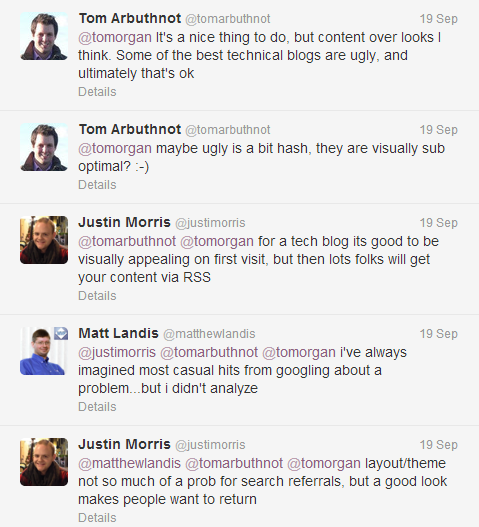Content vs Style
Warning: this is not a post about Lync. That’s sort of the point.
One of the nice things about WordPress is that there’s a good time:value ratio when it comes to visual style and design. That is, if you’re prepared to invest some time thinking about layout and design you can get good results quickly without needing to know everything about WordPress. In fact, without any knowledge at all you can pick from a whole variety of themes, some of which are really excellent and will ensure your site is standards compliant, accessible and browser friendly whilst still looking amazing.
Getting those details right take a long time, so knowing it’s all been done for you is a real bonus. Even if it’s not exactly right, it’s often easier to modify an existing theme than try and “roll your own”; unless of course you have enough time on your hands to learn WordPress styling fully.
This “ease of style” is a real bonus for people like me, who lack the ‘design eye’ needed to produce works of quality, but know something nice when they see it. However, being able to completely change styles so easily can lead to authors giving more thought to appearance than substance. This can happen very easily: I know this because it recently happened to me.
I was looking through some WordPress styles the other day, as I’d decided this blog needed a facelift.
[As an aside, I think the app movement and micro-purchasing model as spearheaded by Apple has really helped other content authors such as those who makes styles and themes for blogs and websites. 5 years ago I would never have considered paying for a theme, now it seems more acceptable. We’ve become used to the idea of paying small amounts of money for added functionality, like a new game or tool. A new theme is no different in this respect. Also, the leap in quality between a free theme and $15 theme is immense and can be excellent value for money when you consider the thought that’s gone into it (mobile, accessible etc.)]
Anyway, I thought I’d decided on a new theme, but I was unsure because it relied heavily on featured images to show different posts. A bit like a magazine-style site, each post would need a rectangle image to define it, otherwise the theme wouldn’t work.
I started to wonder whether I’d even be able to think of an image for each post, let alone have the time to crop and resize the image to ensure it looked good:
Whilst I was thinking this through I got some feedback on my Tweet, from other bloggers in the UC community, whose blogs I read and opinions I respect:
This made me pause, and reconsider what I was doing. Was I doing it for the right reasons, or just because it was easy?
How important is form compared to function?
Having thought about it for a week or so, this is what I reckon. (YMMV of course):
- Content is King. If you have a blog, you should aim to fill it with good-quality posts. It doesn’t have to be incredibly technical if you don’t want it to be, and can cover a number of different subjects, but the important thing is that you have something to say. I’ve started thinking recently about branching out and blogging about other interests other than Microsoft Lync and development, but I need to make sure I do so in a way that doesn’t end up annoying those who only care about Lync Development. I think good category segregation should work here, along with category-specific RSS feeds.
- It’s Your Space. Notwithstanding the first point, this is your place on the Internet. I think nearly everyone should blog. Certainly, every developer should blog. Everyone has something interesting to say, and something to add to the party. Lots of people use Facebook – not just for status updates but for photos and pages and pages of comment, musing and insight. This is a bit like blogging-lite – it’s easier to set up, but it’s not yours. You’re giving up your right to own your thoughts and ideas. If you say something that the company owning the site doesn’t like, it can be deleted without recourse. Even groups and forums, whilst a useful source of information are essentially people giving up their content to another entity, releasing control over it. To own your ideas you need to own your blog. As long as you pay your hosting costs and stay within the law, you can say what you like and no-one can stop you.
- Stop Looking at Analytics. If your blog is in any way commercial or related to sales then ignore this section, maybe. Otherwise: the hits don’t matter. In a subtle alteration of the old adage: “write good content, and they will come”. Concentrate on the content, not on trying to increase traffic.
- Make it yours. Choose a style you like, and to heck with everyone else. It seems good manners to make it accessible and work well on a browser, but if you want it to be bright pink and in the style of a celebrity magazine, go for it! (especially if you’ve found a good theme). What I think I’ve realised in the past week is that there does not have to be a link between how professional a blog looks, and how professional the content is. If you’re writing good content, people will read it. If they’re completely put off by the sausage-dog theme you’ve fallen in love with then they’ll use an RSS reader instead. It’s supposed to be your blog: make it yours.
 All of this blog-meta thinking will probably result in some changes to this blog. I really like the theme I’ve seen (enough to spend $15 on anyway), and I think I can come up with a way of separating content as well. As long as I can keep adding posts (quality content obviously been a very subjective term!) then I won’t feel too bad about spending some time on making it look good.
All of this blog-meta thinking will probably result in some changes to this blog. I really like the theme I’ve seen (enough to spend $15 on anyway), and I think I can come up with a way of separating content as well. As long as I can keep adding posts (quality content obviously been a very subjective term!) then I won’t feel too bad about spending some time on making it look good.







